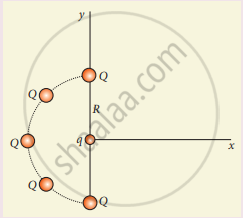Advertisements
Advertisements
Question
Suppose a charge +q on Earth’s surface and another +q charge is placed on the surface of the Moon,
- Calculate the value of q required to balance the gravitational attraction between Earth and Moon
- Suppose the distance between the Moon and Earth is halved, would the charge q change?
(Take mE = 5.9 x 1024 kg, mM = 7.348 x 1022 kg)
Solution
Mass of the Earth, ME = 5.9 x 1024 kg
Mass of the Moon, MM = 7.348 x 1022 kg
Charge placed on the surface of Earth and Moon = q
(a) Required charge to balance the FG between Earth and Moon
FC = FG (or) `1/(4pi epsilon_0) "q"^2/"r"^2 = ("GM"_"E" xx "M"_"M")/"r"^2`
q2 = G × ME × MM × 4πε0 = 320.97 × 1025
q = `sqrt(320.97 xx 10^25)`= 5.665 x 1013 = 5.67 x 1013 C
(b) The distance between Moon and Earth is
`1/(4pi epsilon_0) "q"^2/("r"/2) = ("GM"_"E" xx "M"_"M")/("r"/2)`
so q = 5.67 x 1013 C
There is no change.
APPEARS IN
RELATED QUESTIONS
An electric field `vec"E" = 10 xx hat"i"` exists in a certain region of space. Then the potential difference V = Vo – VA, where Vo is the potential at the origin and VA is the potential at x = 2 m is:
Two points A and B are maintained at a potential of 7 V and -4 V respectively. The work done in moving 50 electrons from A to B is ______.
What is an equipotential surface?
Give the relation between electric field and electric potential.
Define ‘electrostatic potential energy’.
What is meant by electrostatic energy density?
Derive an expression for electrostatic potential due to an electric dipole.
Derive an expression for electrostatic potential energy of the dipole in a uniform electric field.
Five identical charges Q are placed equidistant on a semicircle as shown in the figure. Another point charge q is kept at the center of the circle of radius R. Calculate the electrostatic force experienced by the charge q.

Draw the free body diagram for the following charges as shown in the following figure.

